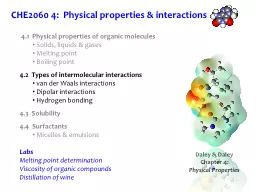

properties amp interactions Daley amp Daley Chapter 4 Physical Properties 41 Physical properties of organic molecules Solids liquids amp gases Melting point Boiling point ID: 613248
Download Presentation The PPT/PDF document "CHE2060 4: Physical" is the property of its rightful owner. Permission is granted to download and print the materials on this web site for personal, non-commercial use only, and to display it on your personal computer provided you do not modify the materials and that you retain all copyright notices contained in the materials. By downloading content from our website, you accept the terms of this agreement.
Slide1
CHE2060 4: Physical properties & interactions
Daley &
Daley
Chapter 4:Physical Properties
4.1 Physical properties of organic molecules Solids, liquids & gases Melting point Boiling point4.2 Types of intermolecular interactions van der Waals interactions Dipolar interactions Hydrogen bonding 4.3 Solubility4.4 Surfactants Micelles & emulsionsLabs Melting point determinationViscosity of organic compoundsDistillation of wineSlide2
Intermolecular interactions
Salt bridges
Van der WaalsDipolar
Hydrogen bondingSlide3
Types of intermolecular interactionsIntermolecular interactions (or forces) act to hold molecules together and
increase melting & boiling points. All involve polarity / charge.
D&D p.184-9
c
ovalentH-bondsdipole-dipoleVan der WaalsAtoms sharing pairs of ve-strongestStrong dipoles interactingTwo polar bonds interactingTemporary dipoles in nonpolar bonds
weakest
Types of intermolecular interactions include:
van
der
Waals forces
dipolar attractions
H-bonding
salt bridgesSlide4
van der Waals attraction
This attractive force occurs when two molecules approach at an optimal distance that allows attraction between the protons & electrons of the
two molecules. Most critical in the liquid phase. When further apart there is no interaction
When closer than optima there is charge-charge repulsion
D&D p.184-9- +- +- +Non-polar molecules experience vdW because they can induce complementary polarization as they approach on another.
vdW
increase with molecular size as “
interactable
” surface area increases
vdW
decrease with branching that
“
interupts
” interactions.
vdW
are weak interactions / strong
when many bonds exist in sum
vdW
are temporary & change
with molecular “environment”
bp
36°C
bp
10°C Slide5
van der Waals attraction
http://antoine.frostburg.edu/chem/senese/101/liquids/faq/h-bonding-vs-london-forces.shtmlSlide6
Dipolar attractionsThis attractive force occurs between
polar molecules.Similar to vdW, but here the dipolar charges are
permanent.
D&D p.186
Dipolar attractions increase intermolecular attraction & boiling point.“Nose to tail”While ethane & fluoromethane have similar MW, their bps differ (-89°C vs -78°C). http://antoine.frostburg.edu/chem/senese/101/liquids/faq/h-bonding-vs-london-forces.shtmlSlide7
Hydrogen bondsThis attractive force occurs between molecules that have hydrogen bond
donors and acceptors.
H-bond donor has a H attached to an electronegative atom (O, N, F) H bond acceptor
has an atom with a lone pair of electrons (O, N, F)
D&D p.186-9H-bonding also increase intermolecular attraction & boiling point. While weak, they are strong when present in high numbers.Slide8
Effect of H-bonding on boiling points
Look at the boiling points of four molecules with similar
MWs
.What makes them different?Molecule
MW (g/mol)Boiling point (°C)CH416-161NH317-33H2O18100HF2019No H-bondsSlide9
Water forms more H-bonds in ice than water
http://
www.visionlearning.com/library/module_viewer.php?mid
=57Each water molecule can form up to four H-bonds with other waters.Ice is less dense than water because it of it’s hydrogen-bonding pattern.
McKee p70In ice water forms acrystalline pattern ofH-bonds, hexagonal,that hold moleculesas far apart as possible.So ice is less dense thanwater.The H-bonds betweenmolecules in liquid water are temporary &less organizedSlide10
Example: intermolecular interactions & bp
Try ranking these three molecules in order of increasing bp.Note that their sizes (MWs
) are similar.
D&D p.186-9
2-nitrophenol 3-nitrophenol 4-nitrophenol215°C 263°C 279°CWhy?Well, 2-nitrophenol tends to H-bond with itself rather than others.Intramolecular bonds don’t hold groups of molecules together & increase bp.Slide11
Example: intermolecular interaction & bp
Try ranking these three molecules in order of increasing bp. Note that their sizes (MWs
) are similar.
D&D p.186-9
cyclohexane 1,4-dioxycyclohexane (aka 1,4-dioxane) 80.74 C bp 101.1 C bpWhy?Cyclohexane is completely non-polar. Its only intermolecular interactions are vdW.Dioxane is a polar molecule and interacts with other molecules via vdW & dipolar attractions. Increased intermolecular bonding results in higher bps.